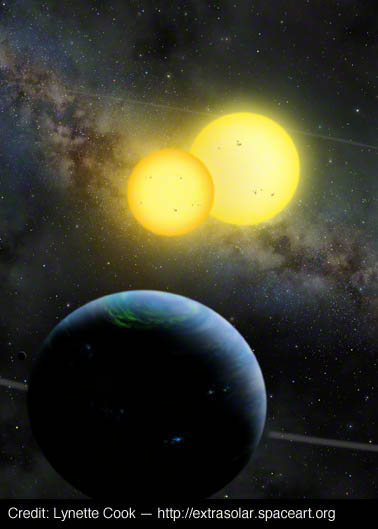Tatooine-Like Alien Planets Could Host Life

Luke Skywalker would be proud. Planets like Skywalker's fictional home of Tatooine in the "Star Wars" movie series might have more potential for habitability than planets in other systems, research suggests.
Tatooine's dual suns might actually help prevent damaging solar winds from bombarding planets in their system, allowing for a wider "Goldilocks zone" of habitability, Joni Clark, an undergraduate at New Mexico State University, said during a poster session at the 222nd meeting of the American Astronomical Society last week. [See Alien Planets With Twin Suns]
"[The stars] calm each other down," Clark told SPACE.com of her new work that expands on earlier studies examining binaries. "It's like a really good marriage. They vent to each other, and they're not focused on anything else. They slow each other down and that causes increased magnetic protection of the planets."
When the stars in a binary are somewhat evenly matched in mass, they can enter into a synchronized dance that keeps solar winds to a minimum.
The stars also need to fully orbit one another within 10 to 30 days to expand the habitable zone. If they drift too far apart, it could put a significant gravitational strain on the orbiting planets. The magnetic fields of the planets aren't necessarily boosted in these kinds of binary systems, Clark said, but they don't have to deal with as much solar assault.
Water worlds and rocky planets could form in areas of the system that might not be habitable without the double star interaction.
"It also leaves the potential open for smaller planets that have less magnetic field protection to remain habitable because in a sense they don't have to protect themselves from as much as they would in a single star case," Clark said.
Get the Space.com Newsletter
Breaking space news, the latest updates on rocket launches, skywatching events and more!
Clark found that some "p-type" planets (that orbit both stars in a binary system) receive 30 percent less flux from solar wind than Earth depending on their position in the solar system.
"Potentially, p-type binaries could have more potential for habitability," Clark added.
In these systems, it's also possible that habitable alien planets could exist as close-in to their stars as Venus is to the sun.
While planets that circle both well-matched stars in a binary system might have an easier time, not all binaries create this extended oasis.
Planets that only orbit one star in a binary can have it rough. If a planet orbits the secondary star in a system, it could get a double dose of solar aggression from stars that are too far apart to synchronize.
Planets that orbit primary stars in a binary, however, basically behave as any planet would in a single star system, Clark said.
Editor's Note: This story was updated on June 19 to reflect a correction. The planets in a p-type binary system receive 30 percent less solar flux than a planet in Earth's position, not 0.7 percent as initially stated.
Follow Miriam Kramer on Twitter and Google+. Follow us on Twitter, Facebook and Google+. Original article on SPACE.com.
Join our Space Forums to keep talking space on the latest missions, night sky and more! And if you have a news tip, correction or comment, let us know at: community@space.com.

Miriam Kramer joined Space.com as a Staff Writer in December 2012. Since then, she has floated in weightlessness on a zero-gravity flight, felt the pull of 4-Gs in a trainer aircraft and watched rockets soar into space from Florida and Virginia. She also served as Space.com's lead space entertainment reporter, and enjoys all aspects of space news, astronomy and commercial spaceflight. Miriam has also presented space stories during live interviews with Fox News and other TV and radio outlets. She originally hails from Knoxville, Tennessee where she and her family would take trips to dark spots on the outskirts of town to watch meteor showers every year. She loves to travel and one day hopes to see the northern lights in person. Miriam is currently a space reporter with Axios, writing the Axios Space newsletter. You can follow Miriam on Twitter.









